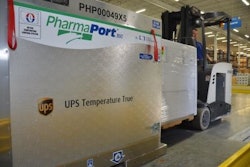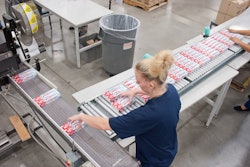Among the many clever folks I met at The Automation Conference this past May was Chris Jones, a controls and automation expert at tna, the Australian packaging machinery OEM that specializes in high-speed combination scales and baggers used for salty snacks and other industries. He recently shared with me this white paper he’d written, and because it speaks to the subject that is at the heart of this newsletter, I present it here.
Technological advances over the last few decades have had a significant impact on manufacturing. Industrial automation has enabled many manufacturers to optimise their production. Others, however, have struggled to integrate new technology into their lines or are unable to take full advantage of the benefits control systems can offer. But with prices for raw materials, labour and energy rising, as well as new regulatory pressure, maximising efficiency remains a key priority for the industry. What are the primary causes of inefficiency in manufacturing plants and what are the best ways to overcome them?
Targeting the inefficiency problem
Inefficiencies in the processing industry are vast and can occur at every stage of the production cycle. They span food safety, material breakage, energy wastage, or may even be caused by badly tuned production lines. Often remaining undetected, or ignored, these inefficiencies always come at a price and can have a visible impact on the profitability and competiveness of a business. While technology might not be able solve all inefficiencies within a production process, it does play a vital role in detecting them. Control systems, such as programmable logic controllers (PLC) and supervisory control and data acquisition (SCADA) systems, can be easily integrated into existing production lines helping to expose inefficiencies. They can also be used to identify where technology could improve workflow. Once analysed, data from these systems helps plant operators target specific areas in which inefficiencies are most prevalent.
Securing food safety through traceability
Food safety is paramount to everyone in the food industry, and maintaining high-quality standards is essential when trying to retain customer loyalty. Product quality issues can apply to both raw materials and the finished product and are often caused by badly specified, outdated, or poorly configured control systems. Besides incurring considerable costs, potential customer complaints can be a real threat to business reputation. With regulators, such as the FDA, pushing for more “preventive” mechanisms to ensure product quality and safety, this type of inefficiency is one that requires urgent attention at many food manufacturing facilities.
By improving traceability throughout the entire production chain, operators will regain control over product quality and food safety. To achieve this, it is important that detailed and reliable data from as many parts of the production process as possible is collected and thoroughly evaluated. Barcode scanning and in-line monitoring systems ensure products are always within specification and adhere to all food safety regulations. Using an effective tracking system to monitor any goods that arrive, controlling existing stock and keeping up to date on products’ shelf life, will help reduce raw material wastage, make inventories more accurate, and maintain product quality at all times.
Keeping waste low
Material waste does not just apply to raw materials. As production lines become more automated, products are now processed at unprecedented speeds, increasing the chances of damage or breakage. Often caused by inaccurate control equipment or badly tuned processes, material waste is a real problem for any plant manager and can affect the entire production cycle. If unnoticed, just one fault could cause damage to a large number of goods, resulting in unnecessary downtime and excessive waste.
With a detailed user requirement specification (URS), control system providers can help identify the required key performance indicators (KPIs) that a particular manufacturing process requires. Once analysed, the URS is then translated into a functional design specification (FDS) that can be used to tighten up the process. The result will be a much smoother and more reliable product flow that will minimise waste and production downtime.
Re-tuning for increased accuracy
While there is no doubt that control systems play a vital role in regulating the production flow, they do not always ensure efficiency from the start. They typically require a precise set-up and careful tuning. Due to practical reasons, however, control systems are rarely commissioned with a full set of finely tuned control loops. As a result, many variables are simply left to chance, causing frequent stoppages, affecting product quality, and diminishing production line efficiency.
It is therefore essential for operators to revisit the original PLC control code and fine-tune the proportional integral derivative (PID) loops. This can be done manually by watching the loop parameters and entering new values for P, I and D or electronically with a dedicated loop tuning package. However, some plants may require more complex loop tuning, in which case operators should consider a model-based controller. This system sits above the PLC control loop on its own PC-based platform and predicts the direction the process is taking, initiating corrective actions before it can deviate from its set points.
Creating an efficient workforce
Although technological progress has now automated the majority of manufacturing processes, labour costs still account for the biggest share of any facility’s budget, and plant managers are understandably keen to get the most out of their workforce. However, multi-tasking is not always easy when outdated procedures prevail. Many plants waste production uptime with maintenance and repair work, while in others, staff are often engaged in repetitive tasks that could be more accurately performed by a machine. This would not only reduce human error, but free up time for staff to focus on more challenging tasks.
A detailed review of each of the processes will be able to identify areas in which tasks are better or more accurately performed by a machine and will free personnel to carry out jobs that are less repetitive. Efficiency can also be improved by pairing an existing PLC system with a concise and clear Human Machine Interface (HMI). This will detect faults much more quickly than the human eye and allow operators to react to faults immediately, minimising downtime and waste.
Controlling energy costs
With increasing automation comes a rise in energy consumption. Although energy use in the US manufacturing sector fell by almost 10 per cent between 2006 and 2010, large amounts of electricity, gas and water are still unnecessarily wasted on a daily basis through outdated or badly maintained machinery. Leaking devices, poor insulation, overheating, unnecessary lights and old fittings further aggravate the situation, all adding to the monthly energy bill. And, with energy prices soaring, keeping a close eye on consumption levels is essential for all operators to maintain profitability. According to the Carbon Trust, a 20% cut in energy costs can represent the same bottom line benefit as a 5% increase in sales.
By deploying sensing equipment, such as flow meters, motion sensors and kWh meters, energy consumption can be monitored across the whole plant. Once a control system has been installed, it can provide operators with detailed energy reports, giving them the viability they need to ensure energy is only used when and where it is needed.
Minimising environmental impact
Keeping energy costs low is also a way of achieving a more efficient and sustainable production process. However, as production output levels increase, so does the amount of discharges and emissions into the environment. Industrial pollution remains a major problem within the industry and poses a real environmental threat. With governments across the globe closing in on polluters, the lack of an effective environmental control system can not only incur huge financial losses, but in some cases even result in plant closures. Detecting violations and leakages quickly is therefore vital to maintain sustainable production.
By installing extra sensing equipment at selected points, plant operators can monitor any waste products before they are discharged. Data from the sensors can then be fed into the PLC system via 4-20mA signals and compared with a set point of acceptability. Depending on the data, the process will either allow discharge or create an out of tolerance alarm, causing the process to stop before any harmful substances are introduced into the environment. The logged data will also provide a detailed record for submission to external monitoring bodies if required, eliminating the risk of large fines and ensuring a safe and efficient operation.
Conclusion
There are a wide variety of inefficiencies in the manufacturing industry, each covering different aspects of the production process. While some are merely expensive, others may pose a real threat to a business. Collecting detailed and reliable data from as many parts of the production process as possible is key to controlling product flows and for safe and effective production.
Control systems can be a real asset to any plant as they will identify areas that require attention and help regulate work flow so all products are within specification. A well-planned, accurate setup with regular maintenance is important in order to achieve optimum efficiency.

























